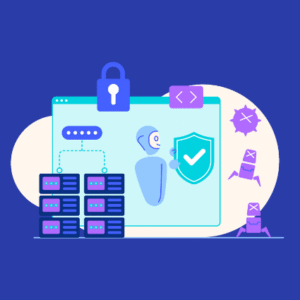Today, cybersecurity threats pose a significant risk to organizations across various industries, including project management.
In the digital workplace, projects increasingly rely on digital tools like marketing automation tools, sales automation tools, and so on.
So, data sharing becomes susceptible to cyber-attacks, data breaches, and other security incidents that can jeopardize project success, stakeholder trust, and organizational reputation.
Therefore, it is crucial for project managers to proactively implement robust cybersecurity measures to protect project assets, information, and stakeholders.
This article outlines ten essential strategies to reduce cybersecurity risk in project management.
By integrating these strategies into project management practices, organizations can enhance their cybersecurity posture, mitigate potential threats, and ensure the secure and successful execution of projects.
Cybersecurity Risks in Project Management

Cybersecurity risks in project management refer to the potential threats and vulnerabilities that compromise the confidentiality, integrity, and availability of project data, resources, and systems.
These risks can have significant implications for the successful and secure completion of projects and organizations’ overall reputation and financial stability. Some of the key cybersecurity risks in project management include:
Data breaches: Unauthorized access to sensitive project data can lead to data breaches, exposing confidential information to malicious actors. This can result in financial losses, legal consequences, and damage to organizational reputation.
Phishing and social engineering attacks: Phishing emails and social engineering tactics are common methods cybercriminals use to trick project team members into revealing sensitive information or downloading malicious software, which can compromise project security and integrity.
Weak access controls: Inadequate access controls and privilege management can result in unauthorized individuals gaining access to project data and resources, leading to data leaks, unauthorized modifications, and potential insider threats.
Insecure project management tools: Using insecure or outdated project management tools that lack robust security features, such as encryption and multi-factor authentication, can make projects susceptible to cyber-attacks and data breaches.
Third-party and vendor risks: Collaborating with third-party vendors, contractors, and service providers who do not adhere to proper cybersecurity practices can introduce additional risks, such as supply chain attacks, data exposure, and compliance violations.
10 Strategies To Reduce the Risk of Cybersecurity

Reducing the risk of cybersecurity threats in project management is crucial for the successful and secure completion of projects. Here are ten strategies to help reduce cybersecurity risks in project management:
Risk assessment and management: Conduct a comprehensive cybersecurity risk assessment at the beginning of the project. Identify potential threats, vulnerabilities, and impacts to prioritize and manage risks effectively throughout the project lifecycle.
Secure project management tools: Use secure and best project management tools that offer robust security features, such as encryption, multi-factor authentication, and regular security updates. Ensure that these tools comply with industry standards and regulations.
Employee training and awareness: Educate project team members about cybersecurity best practices, including password security, phishing awareness, and data protection policies. Regularly update training to address new threats and vulnerabilities.
Access control and privilege management: Implement strict access control measures to ensure that only authorized individuals have access to project data and resources. Use role-based access controls and regularly review and update user privileges based on job roles and responsibilities.
Secure data storage and transmission: Encrypt sensitive project data both at rest and in transit using strong encryption algorithms. Implement secure file sharing and transfer protocols to protect data integrity and confidentiality.
Regular security audits and monitoring: Conduct regular security audits and monitoring to detect and address potential security issues proactively. Utilize intrusion detection systems, log monitoring, and real-time alerts to promptly identify and respond to suspicious activities.
Patch management: Keep all project management software, applications, and systems up to date with the latest security patches and updates. Establish a formal patch management process to ensure timely patching of vulnerabilities and reduce the risk of exploitation.
Backup and recovery planning: Implement a robust data backup and recovery strategy to protect against data loss due to cyber-attacks, system failures, or human errors. Regularly test backup and recovery procedures to ensure data availability and integrity in the event of an incident.
Incident response plan: Develop and maintain a comprehensive incident response plan to outline the steps and procedures for responding to cybersecurity incidents effectively. Ensure that the plan is regularly updated and communicated to all project stakeholders.
Vendor and third-party risk management: Assess and manage the cybersecurity risks associated with third-party vendors, contractors, and service providers involved in the project. Implement contractual obligations and security requirements to ensure that third parties adhere to your organization’s cybersecurity policies and standards.
Conclusion
The ten strategies outlined above provide a roadmap for project managers to enhance their cybersecurity posture, mitigate potential risks, and foster a culture of security awareness and compliance within their teams.
By integrating these strategies into project management practices and continuously monitoring and adapting to the evolving cybersecurity landscape, organizations can effectively mitigate cyber threats, ensure the resilience of their projects, and enhance their business process management securely and efficiently.
Author Bio
I am Geethapriya, a content writer with 2 years of experience in the digital marketing field. I can deliver an engaging and informative article on various subjects. I have worked with numerous clients to create articles, blog posts, website content, news articles, and more. In the digital marketing field, I have skills in creating content that attracts audiences in diverse fields.
WPBN is curated news aggregator website focusing on trending and hot news from the WordPress community.






